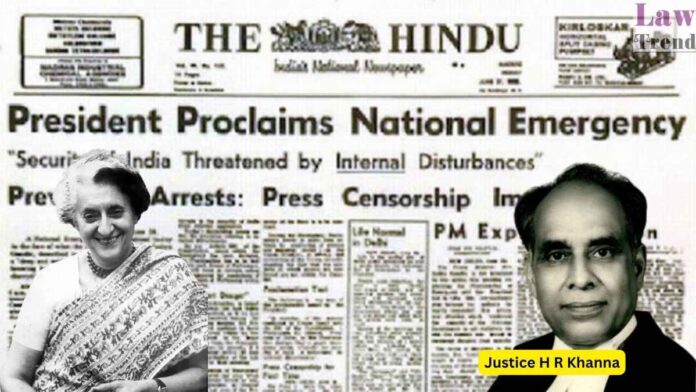As India marks 50 years since the declaration of the Emergency on 25 June 1975, one of the darkest chapters in its democratic history, attention once again turns to the controversial role of the judiciary during this time—particularly the Supreme Court’s stance on the suspension of fundamental rights.
The Emergency, declared by Prime Minister Indira Gandhi citing internal disturbance under Article 352 of the Constitution, saw mass arrests of opposition leaders, severe press censorship, curtailment of civil liberties, and amendments to the Constitution that tilted the balance of power heavily in favour of the executive.
The Legal Challenge to Emergency
In the landmark case that came to define the judiciary’s role during this period, a Constitution Bench of the Supreme Court comprising Chief Justice A. N. Ray and Justices H. R. Khanna, M. H. Beg, Y. V. Chandrachud, and P. N. Bhagwati heard arguments on whether a citizen could approach the courts to challenge unlawful detentions during the Emergency, given that Article 21 (right to life and personal liberty) had been suspended.
The government argued that with Article 21 suspended, even if a person was unlawfully detained, no relief could be sought from any court. Representing the petitioners, legal luminary C. K. Daphtary contended, “The rule of law can neither be suspended nor abolished. Article 21 not only guarantees life and liberty but also the right to legal remedy through courts.”
The 4:1 Verdict and Justice Khanna’s Lone Dissent
The Supreme Court ruled in a 4:1 majority in favour of the government. Chief Justice A. N. Ray wrote, “In times of grave public danger, individual legal rights must give way to the interests of the State.” Justice M. H. Beg held that even the right to legal defence could be curtailed. Justice Y. V. Chandrachud described the declaration of Emergency as “final and beyond judicial scrutiny,” while Justice P. N. Bhagwati concluded that since the arrests were made in accordance with law, detainees had no legal recourse.
Only Justice H. R. Khanna dissented.
In what is now widely regarded as one of the most courageous judgments in Indian judicial history, Justice Khanna held that even during an Emergency, no person could be deprived of life or liberty without legal justification. He asserted, “The question is not whether personal liberty can be restricted, but whether the rule of law itself can be entirely silenced.” He categorically stated that even the President could not suspend the rule of law or legal remedies guaranteed under the Constitution.
Justice Khanna paid the price for his principled stand. Despite being the senior-most judge, he was superseded for the position of Chief Justice in favour of Justice Beg. In protest, Justice Khanna resigned from the Supreme Court.
Background: The Political Context
The immediate trigger for the Emergency was a ruling by the Allahabad High Court on 12 June 1975. Justice Jagmohan Lal Sinha had found Indira Gandhi guilty of electoral malpractices and invalidated her Lok Sabha election from Rae Bareli. A subsequent interim relief from the Supreme Court’s vacation bench allowed her to stay in office but barred her from voting in Parliament.
This judicial blow came at a time when India was already witnessing mass protests in Gujarat and Bihar, with Jayaprakash Narayan leading a popular movement against corruption and authoritarianism. On 25 June 1975, Narayan addressed a massive rally at Delhi’s Ram Lila Maidan, urging the police and army to disobey “illegal” orders from an “immoral” government.
Later that night, police arrested Narayan and other opposition leaders. Indira Gandhi, advised by then West Bengal Chief Minister Siddhartha Shankar Ray, invoked Article 352 to declare a national Emergency. The Cabinet’s approval was obtained the next morning, and President Fakhruddin Ali Ahmed signed the proclamation without delay.
The Aftermath
During the 21-month Emergency (1975–1977), the Constitution was amended multiple times, the press was heavily censored, and lakhs of people—including opposition leaders, activists, and ordinary citizens—were imprisoned. Forced sterilization drives and slum demolitions, particularly under the influence of Sanjay Gandhi, drew widespread criticism.
The Congress machinery echoed slogans like “India is Indira and Indira is India,” while dissent within the party and the government was stifled. Even senior ministers were sidelined in favour of a select group close to the Prime Minister’s son.
Legacy and Reflection
Half a century later, the Emergency remains a stark reminder of the fragility of democratic institutions in the face of authoritarian power. The Supreme Court’s majority decision in the Habeas Corpus case is still seen as a judicial failure to uphold civil liberties. However, Justice H. R. Khanna’s lone dissent continues to inspire generations of jurists, legal scholars, and civil rights activists.
His judgment stands as a timeless testament to judicial independence and the enduring importance of the rule of law in a constitutional democracy.







